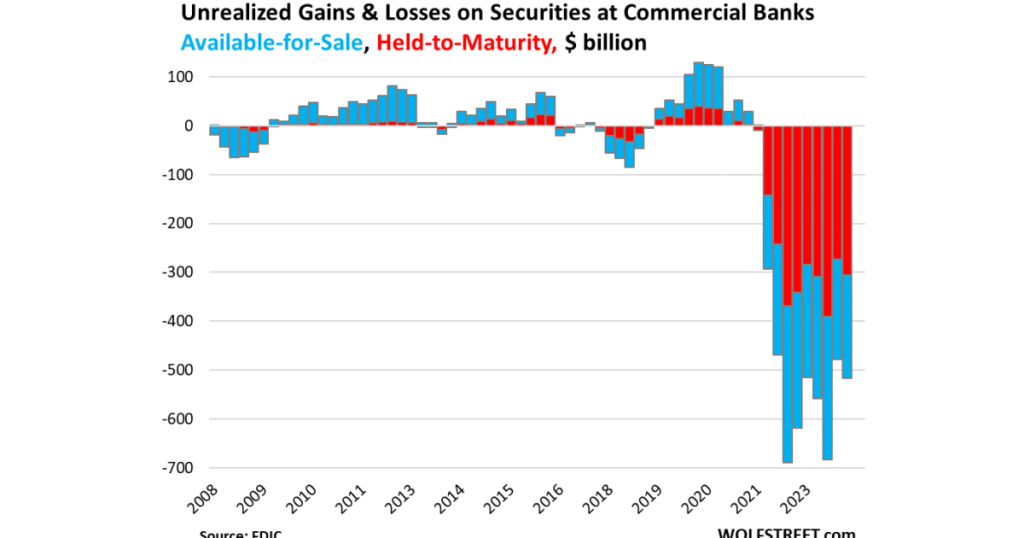Bidenomics. Unrealized gains and losses on securities at commercial banks, credit wolfstreet.com
A ticking time bomb.
In another stark example of the economic mismanagement under the Biden regime, a new report from the Federal Deposit Insurance Corporation (FDIC) reveals a staggering $517 billion in unrealized losses within the US banking system, The Daily Hodl first reported.
This alarming figure, largely due to exposure to the residential real estate market, is a clear indication of the damaging effects of Biden’s failed policies.
The FDIC’s Quarterly Banking Profile report paints a grim picture of the current state of our nation’s financial institutions. Banks are now burdened with more than half a trillion dollars in paper losses on their balance sheets.
Although banks can hold securities until they mature without marking them to market on their balance sheets, these unrealized losses can become an extreme liability when banks need liquidity, per the Daily Hodl.
According to Investopedia, an unrealized loss is a “paper” loss that results from holding an asset that has decreased in price, but not yet selling it and realizing the loss. These losses become “realized” only when the asset is sold at a price lower than its original purchase price.
Source: FDIC
FDIC states in its report, “Unrealized losses on available-for-sale and held-to-maturity securities increased by $39 billion to $517 billion in the first quarter. Higher unrealized losses on residential mortgage-backed securities, resulting from higher mortgage rates in the first quarter, drove the overall increase. This is the ninth straight quarter of unusually high unrealized losses since the Federal Reserve began to raise interest rates in first quarter 2022.”
Alarmingly, the number of banks identified on the FDIC’s Problem Bank List has surged from 52 in the last quarter of 2023 to 63 in the first quarter of 2024.
This classification indicates banks that are on the verge of collapse due to severe financial, operational, or managerial deficiencies. The total assets held by these problematic institutions have swelled by $15.8 billion to $82.1 billion.
Source: FDIC
The CAMELS rating system is used to evaluate the health and stability of financial institutions, such as credit unions and banks, based on six components: Capital adequacy, Asset quality, Management, Earnings, Liquidity, and Sensitivity to market risk.
Each component is rated on a scale from 1 to 5, with 1 being the best and 5 being the worst, and these individual ratings are aggregated into a composite rating.
The Biden administration’s economic policy failures are becoming more evident every day. The growing unrealized losses in our banking system and the increasing number of lenders on the brink of insolvency are just two more examples of how this administration’s mismanagement is leading us down a dangerous path.
The post BIDENOMICS: $517 Billion in Unrealized Losses Cripple US Banking System, 63 Lenders Teeter on the Brink of Insolvency, FDIC Reports appeared first on The Gateway Pundit.







